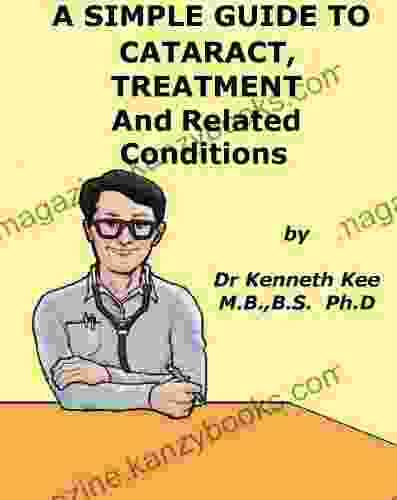Simple Guide To Cataract Treatment And Related Conditions: Your Complete Guide To Vision Restoration

Cataracts are a common eye condition that can affect people of all ages. They occur when the lens of the eye becomes cloudy, which can cause blurred vision, glare, and other vision problems. Cataracts are the leading cause of blindness worldwide, but they can be treated with surgery to restore vision.
This guide will provide you with everything you need to know about cataracts, including symptoms, causes, diagnosis, and treatment options. You will also learn about the latest advancements in cataract surgery and how to improve your vision after surgery.
Cataracts are a clouding of the lens of the eye. The lens is a clear, flexible structure that helps to focus light onto the retina, the light-sensitive tissue at the back of the eye. When the lens becomes cloudy, it can block light from reaching the retina, which can cause blurred vision, glare, and other vision problems.
4 out of 5
| Language | : | English |
| File size | : | 373 KB |
| Text-to-Speech | : | Enabled |
| Screen Reader | : | Supported |
| Enhanced typesetting | : | Enabled |
| Word Wise | : | Enabled |
| Print length | : | 85 pages |
| Lending | : | Enabled |
Cataracts are a common part of the aging process. As we get older, the proteins in the lens of the eye can break down and clump together, causing the lens to become cloudy. Cataracts can also be caused by other factors, such as:
- Trauma to the eye: A blow to the eye can damage the lens and lead to the formation of a cataract.
- Certain medical conditions: Diabetes, uveitis, and glaucoma can all increase the risk of developing cataracts.
- Medications: Some medications, such as steroids and statins, can increase the risk of developing cataracts.
- Exposure to ultraviolet radiation: Prolonged exposure to ultraviolet radiation, such as from the sun or tanning beds, can damage the lens of the eye and increase the risk of developing cataracts.
The most common symptom of cataracts is blurred vision. Other symptoms can include:
- Glare or halos around lights
- Difficulty seeing at night
- Fading or yellowing of colors
- Double vision
- Poor depth perception
The symptoms of cataracts can vary depending on the size and location of the cataract. Small cataracts may not cause any noticeable symptoms, while larger cataracts can significantly impair vision.
Cataracts can be diagnosed with a comprehensive eye exam. During the exam, your eye doctor will:
- Ask about your symptoms and medical history
- Perform a visual acuity test to measure your vision
- Dilate your pupils to examine the inside of your eyes
- Use a slit lamp to examine the lens of your eyes
Your eye doctor may also Free Download other tests, such as an optical coherence tomography (OCT) scan, to get a more detailed view of the lens and retina.
The only effective treatment for cataracts is surgery. Cataract surgery is a relatively simple procedure that can be performed on an outpatient basis. During surgery, the cloudy lens of the eye is removed and replaced with an artificial lens.
There are different types of cataract surgery, including:
- Phacoemulsification: This is the most common type of cataract surgery. It involves using ultrasound waves to break up the cloudy lens into small pieces, which are then removed from the eye.
- Extracapsular cataract extraction: This type of surgery involves removing the entire lens capsule, along with the cloudy lens.
- Intracapsular cataract extraction: This type of surgery involves removing the entire lens, including the lens capsule.
The type of cataract surgery that is right for you will depend on the size and location of the cataract, as well as your overall eye health.
Cataract surgery is generally a very successful procedure. Most people experience significant improvement in their vision after surgery. However, there are some risks associated with cataract surgery, including:
- Infection: There is a small risk of infection after cataract surgery.
- Bleeding: There is a small risk of bleeding during or after cataract surgery.
- Swelling: The eye may swell after cataract surgery, which can cause discomfort and blurred vision.
- Retinal detachment: This is a rare but serious complication of cataract surgery that can lead to blindness.
After cataract surgery, you may need to wear glasses or contact lenses to correct your vision. Your eye doctor will recommend the best option for you based on your individual needs.
There are also a number of things you can do to improve your vision after cataract surgery, including:
- Protect your eyes from the sun: Wear sunglasses that block 100% of ultraviolet radiation.
- Use artificial tears: Artificial tears can help to keep your eyes moist and comfortable.
- Avoid rubbing your eyes: Rubbing your eyes can irritate them and slow down the healing process.
- Follow your eye doctor's instructions: Follow your eye doctor's instructions carefully to ensure a successful recovery.
Cataracts are a common eye condition that can affect people of all ages. However, cataracts can be treated with surgery to restore vision. If you are experiencing any of the symptoms of cataracts, it is important to see your eye doctor for a comprehensive eye exam. Early diagnosis and treatment of cataracts can help to prevent vision loss.
4 out of 5
| Language | : | English |
| File size | : | 373 KB |
| Text-to-Speech | : | Enabled |
| Screen Reader | : | Supported |
| Enhanced typesetting | : | Enabled |
| Word Wise | : | Enabled |
| Print length | : | 85 pages |
| Lending | : | Enabled |
Do you want to contribute by writing guest posts on this blog?
Please contact us and send us a resume of previous articles that you have written.
 Book
Book Novel
Novel Page
Page Chapter
Chapter Text
Text Story
Story Genre
Genre Reader
Reader Library
Library Paperback
Paperback E-book
E-book Magazine
Magazine Newspaper
Newspaper Paragraph
Paragraph Sentence
Sentence Bookmark
Bookmark Shelf
Shelf Glossary
Glossary Bibliography
Bibliography Foreword
Foreword Preface
Preface Synopsis
Synopsis Annotation
Annotation Footnote
Footnote Manuscript
Manuscript Scroll
Scroll Codex
Codex Tome
Tome Bestseller
Bestseller Classics
Classics Library card
Library card Narrative
Narrative Biography
Biography Autobiography
Autobiography Memoir
Memoir Reference
Reference Encyclopedia
Encyclopedia Kenneth Brighenti
Kenneth Brighenti Mark Adkin
Mark Adkin Walter Higgins
Walter Higgins Mark Doyle
Mark Doyle Sarah Gavigan
Sarah Gavigan Ken Fleming
Ken Fleming Yamuna Zake
Yamuna Zake Kevin Kemp
Kevin Kemp Ken Hultman
Ken Hultman Kevin Dobrzynski
Kevin Dobrzynski Neal Lindley
Neal Lindley Rod Smith
Rod Smith Larry P Mahan
Larry P Mahan Ken Liu
Ken Liu Kim Karns
Kim Karns Kifah Dasuki
Kifah Dasuki Kim Mcdevitt Rd
Kim Mcdevitt Rd Toshikazu Kawaguchi
Toshikazu Kawaguchi Laura Allen
Laura Allen Sarah Manguso
Sarah Manguso
Light bulbAdvertise smarter! Our strategic ad space ensures maximum exposure. Reserve your spot today!
 Jedidiah HayesFollow ·19.6k
Jedidiah HayesFollow ·19.6k Sidney CoxFollow ·2.2k
Sidney CoxFollow ·2.2k Chase MorrisFollow ·15.1k
Chase MorrisFollow ·15.1k Jacob FosterFollow ·18.8k
Jacob FosterFollow ·18.8k Bill GrantFollow ·10.3k
Bill GrantFollow ·10.3k T.S. EliotFollow ·5.6k
T.S. EliotFollow ·5.6k Billy FosterFollow ·19k
Billy FosterFollow ·19k Fred FosterFollow ·8.6k
Fred FosterFollow ·8.6k

 Ernesto Sabato
Ernesto SabatoLoving Table: Creating Memorable Gatherings
Gatherings...

 Mark Twain
Mark TwainLifestyle After Cancer: The Facts
Cancer is a life-changing...

 Keith Cox
Keith CoxUnlocking the Nutritional Needs of Individuals with...
Individuals with physical disabilities...

 Rubén Darío
Rubén DaríoHandbook And Guide To Evaluation And Treatment
Empowering Healthcare...

 Andy Hayes
Andy HayesUnveiling the Truth: "Garden Myths" by Robert Pavlis...
The world of gardening is often filled with a...
4 out of 5
| Language | : | English |
| File size | : | 373 KB |
| Text-to-Speech | : | Enabled |
| Screen Reader | : | Supported |
| Enhanced typesetting | : | Enabled |
| Word Wise | : | Enabled |
| Print length | : | 85 pages |
| Lending | : | Enabled |













